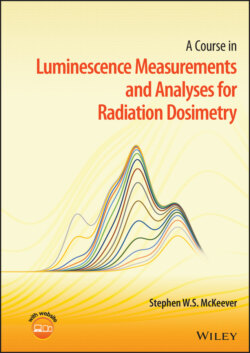Читать книгу A Course in Luminescence Measurements and Analyses for Radiation Dosimetry - Stephen W. S. McKeever - Страница 22
1.3.1 Personal Dosimetry
ОглавлениеFollowing the work by Farrington Daniels and colleagues, the application of TL to the world of dosimetry developed at a rapid pace. TL dosimetry (TLD), using a variety of TLD materials, became the foremost method to be used in the measurement of dose to people. The use of RPL in dosimetry developed slowly in parallel with the dominant application of TLD, while OSL did not become a popular dosimetry tool until the 1990s. Nevertheless, OSL dosimetry (OSLD) has since grown to become perhaps the dominant personal dosimetry method throughout the world, even though the availability of OSLD materials is rather limited. Today, in the world of luminescence personal dosimetry, TLD, OSLD, and radiophotoluminescence dosimetry (RPLD) each have their niches and one or other is the preferred dosimetry method in many institutions around the world.
TLD personal dosimeter badges have been designed by a wide range of companies and institutions, and a myriad of badge designs are available. Figure 1.5 displays several of them. (OSLD and RPLD badges are also included in this figure.) Each TLD badge contains a suitable TL material (the most popular of which is the first TLD material to be developed, namely LiF:Mg,Ti), along with an array of radiation filters (different metals or plastics of different thicknesses) to enable the analysis of the TLD badges to reveal not only dose, but also to provide some information about the radiation type and quality (i.e., energy). This is important to allow the dosimetry service provider to present information concerning how penetrative was the radiation to which the badge wearer was exposed.
Figure 1.5 Examples of personal dosimeters, including TLD, OSLD and RPLD badges. (Also included are some examples of electronic dosimeters.) Source: Dr. Hannes Stadtmann, © Hannes Stadtmann, European Radiation Dosimetry Group (EURADOS).
TLD badges are used everywhere that requires the monitoring of radiation workers at radiation facilities (nuclear power stations, hospitals, industrial complexes, and many others), including guest visitors to those facilities. Although TLD badges are slowly being phased out and replaced by other technologies (such as electronic dosimeters, some of which are also shown in Figure 1.5), they remain a powerful presence in the world of personal radiation dosimetry.
Also shown in Figure 1.5 are some of the OSLD and RPLD badges that are commercially available. While OSLD has become an extremely popular luminescence method for personal dosimetry, RPLD occupies a smaller portion of the luminescence dosimetry market share.
Commercial TLD materials include those based on LiF (e.g. LiF:Mg,Ti and LiF:Mg,Cu,P), CaF2 (e.g. CaF2:Mn, CaF2:Dy, and CaF2:Tm), Li2B4O7 (e.g. Li2B4O7:Cu), MgB4O7 (e.g. MgB4O7:Mn, MgB4O7:Dy, and MgB4O7:Cu), Al2O3 (e.g. Al2O3:C; Al2O3:Si,Ti, and Al2O3:Mg,Y) and CaSO4 (e.g. CaSO4:Tm and CaSO4:Dy). Other, less well-known and utilized materials have often been described in the published literature, including natural minerals (e.g. calcite, fluorite, quartz). OSLD is dominated by Al2O3:C and BeO, while RPLD is dominated by Ag-doped alkali phosphate glass, and Al2O3:C,Mg.
The material properties that are important in personal dosimetry are a high sensitivity (large signal for a given dose), a linear dose-response relationship, angle independence, and energy independence. The latter is difficult to achieve at low radiation photon energies. However, the important property in this regard is that the material responds to low-energy photons in the same way as does human tissue – a property known as tissue-equivalence. The most important characteristic for tissue equivalence is the effective atomic number Zeff of the material. Here, materials such as LiF (Zeff = 8.14), BeO (Zeff = 7.4) and Li2B4O7 (Zeff = 7.13) have advantages over other materials since these values are close to that of tissue (Zeff = 7.4). However, tissue equivalence is not essential as long as the response at low energies is well defined such that suitable corrections can be made (for example Al2O3:C with Zeff = 10.2).
